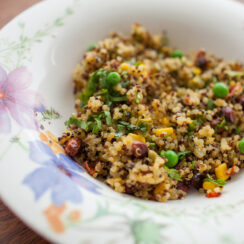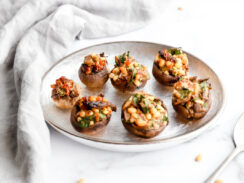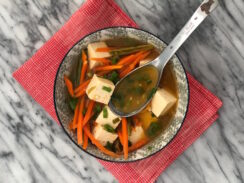EASY TRI-COLOR VEGETARIAN QUINOA RECIPE
Quinoa is definitely taking over restaurants and home kitchens around the world, but I like to put my spin on it using Indian flavorings such as ginger, cumin seeds, mustard seeds, curry leaves, and curry powder. The spice mix is really what makes it, so feel free to adjust the spices in the recipe to suit your taste!
This Vegan Quinoa Salad is an easy recipe to whip up and eat as a main meal; add chickpeas and tofu for even more protein. This recipe is complete and loaded with veggies, nuts, herbs, and spices and has tons of flavor! I love using tri-color quinoa, partially because it makes for a gorgeous dish, but I also love that it’s slightly chewier in texture, and has a somewhat nuttier taste compared to white quinoa. It is gluten-free, rich in protein, has twice the amount of fiber when compared to other grains, and is a great substitute for rice in healthy dishes.

Curried Tri-Color Quinoa
Ingredients
- 1 cup quinoa
- 3 tablespoons canola oil or olive oil
- 1/2 cup peanuts or cashews, (raw)
- 1 teaspoon mustard seeds
- 1 teaspoon cumin seeds
- 1 sprig curry leaves
- 1/2 yellow onion, (finely chopped)
- 2-3 green chilies, (chopped, optional)
- 1 tablespoon curry powder
- 1 medium tomato, (chopped)
- 1 tablespoon fresh ginger, (grated)
- 1/2 cup frozen peas
- 1/2 cup frozen corn
- 2 cups vegetable broth
- 2 tablespoons lemon juice
- 1/4 cup cilantro, (washed, finely chopped)
- Salt
- lemon slice, (for garnish)
Instructions
INSTRUCTIONS/NOTES FOR STOVETOP:
- Heat oil in a pan.
- Add raw peanuts or cashews and lightly fry for 2 minutes.
- With a slotted spoon, remove the peanuts or cashews and set aside on a paper towel.
- To the pan, with the oil, now add mustard and cumin seeds.
- When crackling starts, add curry leaves, chopped onions, and green chilies, and cook for 1-2 minutes.
- Add salt and curry powder and stir, letting cook for another minute.
- Add ginger, peas, corn, and chopped tomato, and cook until tomato turns mushy (about 2-3 minutes).
- Add vegetable broth and bring to a boil.
- Stir in quinoa and lemon juice and let boil for 4-5 minutes.
- Reduce flame to medium and cover with the lid. Let it cook until all liquid is absorbed by quinoa (about 15 minutes).
- Turn off the flame and stir in peanuts or cashews and cilantro.
- Using a fork, fluff up the quinoa. Cover, and let it sit for 5 minutes before serving. Serve with a lemon slice as a garnish.
INSTRUCTIONS/NOTES FOR INSTANTPOT:
- Place the Instantpot on “Saute” mode and let the bowl heat up for a few minutes. Add the canola oil and let it heat for a few seconds.
- Add the raw peanuts or cashews and lightly fry for 2 minutes.
- With a slotted spoon, remove the peanuts or cashews and set aside on a paper towel.
- Add the mustard and cumin seeds to the oil in the pan.
- When crackling starts, add the curry leaves, chopped onions, and green chilies, and cook for 1-2 minutes.
- Add salt and curry powder and stir, letting cook for another minute.
- Add the ginger, peas, corn, and chopped tomatoes, and cook until the tomatoes are completely broken down and mushy (about 2-3 minutes).
- Add the vegetable broth and let it come to a boil/simmer- this may take a few minutes.
- Stir in the quinoa and lemon juice and let it boil for 2-3 minutes.
- Turn off the Instantpot and press “Pressure Cook” or “Manual” on some models. Set it to “High Pressure” and set the timer for 1 minute using the +- buttons. Cover the Instantpot with a lid and turn the nozzle at the top to the “Sealing” position.
- Allow the pressure to release naturally for 10 minutes and then release any remaining pressure.
- Take the cover off and stir in the peanuts or cashews and finely chopped cilantro.
- Using a fork, fluff up the quinoa. Cover, and let it sit for 5 minutes before serving. Serve with a lemon slice as a garnish.
Bon appétit!
DOES QUINOA CONTAIN GLUTEN?
Short answer- No, quinoa is gluten-free.
Quinoa is often mistaken for cereal grain. However, it’s a pseudocereal seed (as are chia seeds and amaranth, for example) despite the fact its appearance, texture, and nutritional makeup mimics that of true cereal grains. Certain types of cereal grains (wheat berries, rye, spelt, barley) contain gluten, which is a protein that can cause uncomfortable symptoms such as bloating, gas, and fatigue for those with celiac disease or gluten sensitivity. Gluten has been studied to trigger an immune response in people with celiac disease, causing their immune system to attack healthy cells in their bodies. Quinoa is the perfect alternative for those looking for a gluten-free complex carbohydrate option to incorporate into their meals.
For those who have celiac disease and cannot tolerate even the smallest amount of gluten cross-contamination, it’s important to look out for the gluten-free certification when shopping for quinoa products. The reason for this is that it’s often grown, harvested, and processed in the same facility with glutinous grains like wheat. Cross-contamination can also occur if you buy your quinoa in those bulk bins at grocery stores, which tend to share scoops with other bins. A few of my favorite quinoa brands that make products in a dedicated gluten-free facility include Bob’s Red Mill (I also use their GF rolled oats in my other recipes), Ancient Harvest, which sells all kinds of certified GF quinoa products including pasta using a combination of quinoa and corn flours, and true roots, a producer of sprouted quinoa. These brands are easy to find in Whole Foods, your local health food store, or even on Amazon, where you can get discounts for buying quinoa in bulk to stock your pantry.
IS QUINOA HEALTHIER THAN RICE?
For years, brown rice has been considered to be a great source of nutritious complex carbohydrates in Western diets. These days, people are often substituting quinoa for brown rice in their diets. Rice is a gluten-free cereal grain containing fiber, some protein, B vitamins, and minerals. Both quinoa and rice have been staples in healthy diets around the globe for centuries. So how do these two compare in nutrition?
Protein: Brown and white rice both contain about 5 grams of protein/cup, compared to quinoa coming in at 8 grams of protein/cup. Quinoa is also a complete protein, with all 9 essential amino acids. Rice is low in the amino acid lysine but high in methionine. Combining rice and beans (high in lysine and low in methionine) provides the complete amino acid profile. Traditional beloved dishes such as red rice and beans, peanut butter and jelly on bread, corn chips and bean dip, and Pasta e Fagioli, a soup made with pasta, beans, and vegetables are all modern renditions of bean and grain combinations that have been used in culinary practices for thousands of years.
Carbohydrates: If you aim to cut down on your carb intake, choose quinoa over brown rice as it contains 39 grams of carbs in 1 cup, whereas brown rice contains 45 grams in 1 cup. Not a huge difference but it does add up if you’re counting carbs.
Micronutrients: Both brown rice and quinoa have impressive micronutrient profiles. Brown rice is a good source of phosphorus, manganese, magnesium, and selenium. However, it has lower amounts of copper, calcium, and zinc. Quinoa is high in iron, manganese, phosphorus, magnesium, and zinc, plus it contains high levels of calcium, potassium, and selenium. Quinoa is known to be 3 times more nutritious in micronutrients than brown rice.
Taste and Texture: Most people are used to eating rice so they may not choose to eat quinoa consistently. Hence why taste and texture are a determining factor when deciding between the two, brown rice has a nutty flavor and a firm, chewy texture. Quinoa is smaller than rice and has a slightly rougher texture.
DOES QUINOA HAVE MORE PROTEIN THAN MEAT?
On a vegan or vegetarian diet, it’s essential to make sure you’re clocking in enough protein daily. The amount that a person requires varies based on their weight, gender, and activity level. When it comes to plant-based protein, aim for 46 grams of protein per day if you’re a woman, or 56 grams if you’re a man. As a rule of thumb, protein should make up 12-20 percent of your day’s total calories. As a vegan myself, I’m constantly being asked “Where do you get your protein from?” It’s a common misconception that you have to consume meat to get enough protein. Vegans – just like cows, pigs, sheep, and chickens – get their protein directly from plants.
Unlike other grains, quinoa is a source of complete protein in the vegan diet. According to Healthline, quinoa contains an impressive 8 grams per cooked cup of quinoa, providing more protein than a cooked egg. However, when compared to meat, quinoa has half the amount of protein per ounce. This isn’t a major issue in a vegan diet because the truth is that, fruits, vegetables, grains, nuts, seeds, and legumes all have protein and, with careful planning, you can get just as much protein as all of the carnivores out there.
HOW TO COOK QUINOA – STOVETOP, RICE COOKER, AND INSTANT POT:
For some people, the bitter flavor of quinoa isn’t noticeable and for others, it’s one of the reasons why they may choose to forgo eating the grain. However, washing off the bitter flavor makes a huge difference in the taste.
Before cooking, take a few minutes and be sure to rinse the grain in a fine-mesh strainer no matter what cooking method you’re using. Even if the quinoa has a “prewashed” label, I find that you still need to rinse it in cold water to remove the saponins — a naturally occurring coating that acts as pest control for the plant. The bitter taste of these compounds makes the plant less palatable to birds, insects, and humans. The word “saponin” comes from the Latin word, “Sapo,” which means soap. Due to their foaming properties, saponins are also added to shampoos, soap, household cleaners, and makeup products.
Another trick I picked up in culinary school to make quinoa taste amazing is to toast it. Before adding any cooking liquid (water or broth), place the quinoa in a pan with a little bit of olive oil and toast it for a few minutes until it becomes darker in color and you can smell the toasted aroma. Be careful not to burn it!
Cooking Methods
Stovetop method: This is the easiest way to prepare quinoa if you just have a single pot and no other special equipment. After rinsing (and/or toasting) the quinoa, add it to a small pot with a liquid of your choice and a sprinkle of salt. You can also add aromatics for flavors such as cloves of smashed garlic, a few bay leaves, and sprigs of rosemary or thyme. No matter the quantity you decide to use, follow a ratio of 1 3/4 cups of liquid for every cup of quinoa (1 3/4:1). Many boxes call for a 2:1 ratio, but I find that this results in a mushier texture. Bring everything in the pot to a boil quickly cover the pan and reduce the heat to medium. In 15 minutes, check to see if all of the water has been absorbed and that the tiny spirals (the germs) separate and curl around the seed. If there’s still a small amount of water left, don’t worry. This will provide steam in the last part of the cooking process. At this point, turn off the heat and allow the quinoa to sit covered for 5 minutes, while the steam and heat finish the cooking process. Finally, open the pot and use a fork to fluff up before serving.
Rice cooker method: Place the rinsed quinoa and cooking liquid in your rice cooker. Add salt to taste as well as any optional aromatics and set it on the “white rice or rice” setting, depending on your model. Most will complete the cooking process in 15 minutes. Once it’s done cooking, wait a few minutes and then fluff it with a fork.
Instantpot method: If you’re the proud owner of an Instantpot, just wait till you discover how quickly you can whip up a pot of quinoa. Combine the rinsed quinoa, cooking liquid, salt to taste, and optional aromatics in the Instantpot and close the lid, making sure that the lever at the top is in the “Sealing” position. Press “Pressure Cook” and set the timer to 1 minute. When it beeps, turn off the Instantpot and let it naturally release pressure. Open the lid and fluff it up with a fork.
Quinoa is one of the healthiest and most versatile ingredients that can be used to make interesting dishes. If you’re not already eating it every day, here are some other quinoa recipes to start incorporating the seed into your diet:

